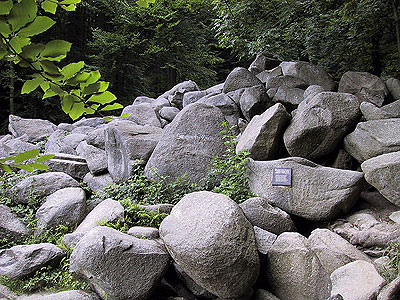|

Das Reichenbacher Felsenmeer ist Teil des "UNESCO
Geo-Naturparks Bergstrasse-Odenwald". Entstanden ist das Felsenmeer
vor ca. 340 Millionen Jahren. In der Subduktionszone kam es im
Bereich des Oberen Erdmantels zur Bildung von Gesteinsschmelzen.
Diese Schmelzen (Magmen) stiegen langsam aus der Tiefe aus und
erkalteten in der Erdkruste als Plutonite (erstarrte Magma im
Erdinneren).
Im Gebiet des
heutigen Felsberg bildeten sich in einer Tiefe von 12–15km ein
mächtiger Intrusivkörper aus Quarzdiorit. Dieses kristalline
Gestein gehört zur Familie der Granitoide. Es besteht im
wesentlichen aus den Mineralen Feldspat, Pyroxen, Hornblende und
Quarz.
Der
Quarzdiorit hatte eine Entstehungstemperatur von etwa 550°C und
brauchte 10 Millionen Jahre bis zur Abkühlung auf 300 °C. Im
Verlauf dieser Abkühlung kam es im Gestein durch Schrumpfungen zu
ersten Rissen und Klüften.
Vor 280
Millionen Jahre waren diese Prozesse abgeschlossen und der Odenwald
bildete ein Teil des Varistischen Gebirge, das sich quer durch
Mitteleuropa erstreckte. Dieses Varistische Gebirge ist mit den
heutigen Alpen vergleichbar.
Bis zum
Tertiär (65 Millionen Jahren) wurde das überdeckte Gebirge (5–8km)
abgetragen und der Quarzdioritkörper stieg bis zur Erdoberfläche
auf. Gleichzeitig brach im Tertär der Rheingraben ein, was ein
weiteres herausheben des Bergsträßer Odenwalds bewirkte. In Folge
der Druckentlastung vertieften sich die schon vorhandenen Risse und
Klüfte im Gestein und zerteilten den massigen Intrusivkörper in
quaderförmige Blöcke. Der nun an der Oberfläche aufgeschlossene
Quarzdiorit war jetzt der starken chemischen Verwitterung eines
subtropischen Klimas ausgesetzt. Diese reichte bis in mehrere
Zehnermeter Tiefe und führte zur randlichen Zersetzung der
Gesteinsblöcke. Um die Blöcke reicherte sich das
Verwitterungsmaterial, der „Grus“, an. Der Grus ist ein Gemisch aus
Kies und Tonminerale.
Die heutige
Form des Felsenmeers bildete sich aber erst in junger geologischer
Zeit während der letzten Eiszeiten (Pleistozän). Vor etwa 12.000
Jahren in der letzten Eiszeit war der Odenwald nicht von Eis
bedeckt, aber er lag in einem Permafrostgebiet (ähnlich Tundra). So
konnte in den wärmeren Jahreszeiten der Boden auftauen und Wasser
spülte die Felsblöcke von dem Grus frei. In den kalten Jahreszeiten
gefror der Boden und es bildeten sich Eiskeile im Untergrund und in
den Klüften der Blöcke. Der Quarzdiorit wurde praktisch auseinander
gesprengt, es wirkte der Prozess der Frostverwitterung.
Die so
freigelegten Blöcke kamen in Bewegung und glitten die Talflanken
hinab und bildeten dort große Blockmeere, das Felsenmeer. Der
Verwitterungsprozess, der den Gesteinsblöcken ihr typisches
Aussehen verleiht, wird als „Wollsackverwitterung“
bezeichnet.
 Die Römer haben den Granit
der Gegend als Steinbruch benutzt, zum Beispiel für den Dom in
Trier. Sie hinterließen dabei über 300 teilweise bearbeitete
Steine, insbesondere eine römische Säule und den Altarstein.
In manche teilbearbeitete Steinbrocken hat man Formen
hineininterpretiert, so z.B. das Riesenschiff oder den
Krokodilfelsen. Die Römer haben den Granit
der Gegend als Steinbruch benutzt, zum Beispiel für den Dom in
Trier. Sie hinterließen dabei über 300 teilweise bearbeitete
Steine, insbesondere eine römische Säule und den Altarstein.
In manche teilbearbeitete Steinbrocken hat man Formen
hineininterpretiert, so z.B. das Riesenschiff oder den
Krokodilfelsen.
Weitere
Informationen zum Felsenmeer findest du
hier.
Zum Loggen dieses Earthcaches benötigst Du ein Foto
Deinem GPS (und wenn möglich, von Dir selber) vor der
"Siegfriedsquelle" (N49° 43.340 E8° 41.575) am unteren Ende
des Felsemmeers. Logs ohne Foto werden leider gelöscht.
Von hier aus
kannst Du übrigens auch weitere Caches angehen, z.B. den
Erliots "Sea of Rocks" oder auch meinen
Multicache"Am Borstein".
Viel Spaß
beim Entdecken des Felsenmeeres wünscht euch...
Uwe aka
"Gagravarr"
|